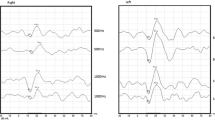Abstract
Diagnosis of Meniere’s disease is mainly clinical although many tests have been studied for efficacy in diagnosis of Meniere’s disease. Glycerol test is a functional test to identify hydrops in Meniere’s disease and can be done with PTA, Speech audiometry, otoacoustic emission, EcochG and cVEMP as its outcome measures. The study aimed to compare two outcome measures of glycerol test to identify Meniere’s disease; to determine whether the stage of Meniere’s disease affected glycerol outcomes; and to attempt to identify independent variables that could predict outcomes of glycerol test. 26 ears of 20 Meniere’s disease participants were evaluated using PTA-based and cVEMP-based glycerol tests. Each test identified ten of 26 ears with Meniere’s disease; and high agreement was noted in the two outcome measures. The stage of Meniere’s disease based on four frequency hearing threshold average was not associated with outcome of glycerol test, but staging of Meniere’s disease based on symptom duration was associated with glycerol test results. As the duration of symptoms increased there was lesser chance of positive outcomes on glycerol test; but intermediate stages of Meniere’s disease showed positive outcomes. Variables such as age, gender, severity of hearing loss, duration of symptoms and pre-glycerol cVEMP measurements could not predict glycerol test outcomes. PTA-based and cVEMP- based glycerol tests hold promise in the test battery for identification of Meniere’s disease. Positive findings on the test lead to confirmatory diagnosis but a negative glycerol test does not rule out Meniere’s disease.

Similar content being viewed by others
References
Okuno T, Sando I (1987) Localization, frequency, and severity of endolymphatic hydrops and the pathology of the labyrinthine membrane in Meniere’s disease. Ann Otol Rhinol Laryngol 6(4):438–445
Committee on Hearing and Equilibrium Guidelines for the (1995) Diagnosis and evaluation of therapy in Meniere’s disease. American Academy of Otolaryngology–Head Neck Foundation, Inc. Otolaryngol Head Neck Surg 113:181–185
Fiorino F, Pizzini FB, Beltramello A, Mattellini B, Barbieri F (2011) Reliability of magnetic resonance imaging performed after intratympanic administration of gadolinium in the identification of endolymphatic hydrops in patients with Ménière’s disease. Otol Neurotol 32(3):472–477
Booth JB (1980) Meniere’s disease: the selection and assessment of patients for surgery using electrocochleography. Ann R Coll Surg Engl 62:415–425
Singh NK, Krishnamurthy R, Premkumar PK (2015) Relative efficiency of cochlear hydrops analysis masking procedure and cervical vestibular evoked myogenic potential in identification of Meniere’s disease. Adv Otolaryngol. https://doi.org/10.1155/2015/978161
Akkuzu G, Akkuzu B, Ozluoglu LN (2006) Vestibular evoked myogenic potentials in benign paroxysmal positional vertigo and Meniere’s disease. Eur Arch Otorhinol 263:510–517
de Waele C, Huy PT, Diard J, Freyss G, Vidal P (1999) Saccular dysfunction in Meniere’s patients. Am J Otol 20:223–232
Egami N, Ushio M, Yamasoba T, Yamaguchi T, Murofushi T, Iwasaki S (2013) The diagnostic value of vestibular evoked myogenic potentials in patients with Meniere’s disease. J Vestib Res 23:249–257
Sinha SK, Sarvanan P (2013) Utility of Vestibular evoked myogenic potentials in the diagnosis of Meniere’s disease: a review. J Hearing Sci 3(3):RA9–RA15
Singh NK, Barman A (2016) Utility of the frequency tuning measure of oVEMP in differentiating Meniere’s disease from BPPV. J Am Acad Audiol 00:1–14. https://doi.org/10.3766/jaaa.15141
Cianfrone G, Ralli G, Fabbricatore M, Altissimi G, Nola G (2000) Distortion product otoacoustic emissions in Meniere’s disease. Scand Audiol 29:111–119. https://doi.org/10.1080/010503900424525
Magliulo G, Cuiuli G, Gagliardi M, Ciniglio-Appiani G, D’Amico R (2004) Vestibular evoked myogenic potentials and glycerol testing. Laryngoscope 114:338–343
Young Y, Huang T, Cheng P (2003) Assessing the stage of Ménière’s disease using vestibular evoked myogenic potentials. Arch Otolaryngol Head Neck Surg 129(8):815–818
Murofushi T, Shimizu K, Takegoshi H, Cheng PW (2001) Diagnostic value of prolonged latencies in the vestibular evoked myogenic potential. Arch Otolaryngol Head Neck Surg 127:1069–1072
Rauch SD, Zhou G, Kujawa SG, Guinan JJ, Herrmann BS (2004) Vestibular evoked myogenic potentials show altered tuning in patients with Ménière’s disease. Otol Neurotol 25:333–338
Klockhoff I, Lindblom U (1967) Glycerol test in Ménière’s disease. Acta Otolaryngol 224:449–451
Carhart R, Jerger JJ (1959) Preferred method for clinical determination of pure-tone thresholds. J Speech Hearing Disord 24:330–345
Ban JH, Lee JK, Jin SM, Lee KC (2007) Glycerol pure tone audiometry and glycerol vestibular evoked myogenic potential: representing specific status of endolymphatic hydrops in the inner ear. Eur Arch Otorhinolaryngol 264(11):1275–1281
Magliulo G, Parrotto D, Gagliardi M, Cuiuli G (2008) Vestibular evoked periocular potentials in Meniere’s disease after glycerol testing. Ann Otol Rhinol Laryngol 117(11):800–807
Murofushi T, Matsuzaki M, Takegoshi H (2001) Glycerol affects vestibular evoked myogenic potentials in Meniere’s disease. Auris Nasus Larynx 28(3):205–208
Selvakumar P, Balraj A, Kurien R, Krishnan T (2011) Clinical and audio vestibular profile of Meniere’s disease in a Tertiary Care Centre in India. Indian J Otolaryngol Head Neck Surg 64(4):351–355. https://doi.org/10.1007/s12070-011-0352-1
Ozeki H, Iwasaki S, Murofushi T (2008) Vestibular drop attack secondary to Meniere’s disease results from unstable otolithic function. Acta Otolaryngol 128(8):887–891. https://doi.org/10.1080/00016480701767390
Ban JH, Lee JK, Jin SM, Lee KC (2007) Glycerol pure tone audiometry and glycerol vestibular evoked myogenic potential: representing specific status of endolymphatic hydrops in the inner ear. Eur Arch Otorhinolaryngol 264(11):1275–1281
Damian J, Dyckman C, Sauder CL, Ray CA (2011) Glycerol-induced fluid shifts attenuate the vestibulo-sympathetic reflex in humans. Am J Physiol Regul Integr Comp Physiol 300(3):R 630–R 634
Lütkenhöner B, Basel T (2014) Reappraisal of the glycerol test in patients with suspected Menière’s disease. BMC Ear Nose Throat Disord 14:12. http://www.biomedcentral.com/1472-6815/14/12
Kim MB, Choi J, Byun HY, Park GY, Chung WH (2013) Clinical value of VEMP in Meniere’s disease. Clin Exp Otorhinolaryngology 6(2):57–62. https://doi.org/10.3342/ceo.2013.6.2.57
Author information
Authors and Affiliations
Corresponding author
Ethics declarations
Conflict of interest
The authors state no conflict of interest. The authors declare that the manuscript has been read and approved by both the authors, the requirements for authorship have been met, and each author believes that the manuscript represents honest work.
Rights and permissions
About this article
Cite this article
Valame, D.A., Gore, G.B. Role of Cervical Vestibular Evoked Myogenic Potentials (cVEMP) as Outcome-Measure of Glycerol Test. Indian J Otolaryngol Head Neck Surg 71 (Suppl 1), 425–433 (2019). https://doi.org/10.1007/s12070-018-1335-2
Received:
Accepted:
Published:
Issue Date:
DOI: https://doi.org/10.1007/s12070-018-1335-2




